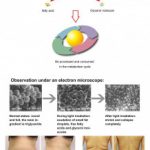Hello, in this presentation, we will be discussing the topic of light therapy. This therapy involves using different types and intensities of light to treat various medical conditions, including skin disorders, seasonal affective disorder, and sleep disorders. Through this presentation, we will explore the different types of light therapy, their benefits, and their potential side effects.
Contents
Understanding the Science Behind Light Therapy
Light therapy is a non-invasive treatment that uses specific wavelengths of light to penetrate deep into the body’s tissues, promoting healing and reducing pain. It has been used for centuries in different cultures, and it is now widely recognized as an effective therapy for a variety of conditions, from depression and anxiety to skin problems and chronic pain.
The science behind light therapy is based on the fact that different wavelengths of light have different effects on the body. For example, blue light has been shown to help regulate circadian rhythms and improve sleep, while red light has been shown to reduce inflammation and stimulate collagen production in the skin.
Light therapy works by targeting specific areas of the body, either through direct exposure to light or through the use of light-emitting devices such as light therapy lamps, LED light panels, and infrared heating pads.
Benefits of Light Therapy
Light therapy has numerous benefits for both physical and mental health. Here are just a few of the ways it can help improve your overall well-being:
Light therapy is a non-invasive treatment that uses specific wavelengths of light to penetrate deep into the body’s tissues, promoting healing and reducing pain. Different wavelengths of light have different effects on the body, and light therapy targets specific areas of the body either through direct exposure to light or through light-emitting devices. Light therapy has numerous benefits for physical and mental health, including reducing pain and inflammation, improving mood and energy, and promoting skin health. Different types of light therapy are effective for different conditions, and it is important to consult with a healthcare professional before starting any type of light therapy.
1. Reduces Pain and Inflammation
Light therapy has been shown to be effective in reducing pain and inflammation in conditions such as arthritis, back pain, and fibromyalgia. It works by increasing blood flow to the affected area, reducing inflammation, and promoting the release of endorphins, the body’s natural painkillers.
2. Improves Mood and Energy
Light therapy is an effective treatment for seasonal affective disorder (SAD), a type of depression that occurs during the winter months when there is less natural sunlight. It has also been shown to be effective in treating other types of depression and improving overall mood and energy levels.
3. Promotes Skin Health
Light therapy is a popular treatment for a variety of skin conditions, from acne to psoriasis to wrinkles. It works by stimulating collagen production, reducing inflammation, and killing bacteria that can cause acne.
Types of Light Therapy
There are several types of light therapy, each with its own specific benefits and applications. Here are some of the most common types of light therapy:
Light therapy is a non-invasive treatment that uses specific wavelengths of light to penetrate deep into the body’s tissues, promoting healing and reducing pain. Different wavelengths of light have different effects on the body, and light therapy works by targeting specific areas of the body through direct exposure to light or through the use of light-emitting devices. It has numerous benefits for both physical and mental health, including reducing pain and inflammation, improving mood and energy levels, and promoting skin health. There are several types of light therapy, each with its own specific benefits and applications, and it is important to consult with a healthcare professional to determine which type is best for your specific needs.
1. Red Light Therapy
Red light therapy is a type of light therapy that uses red or near-infrared light to penetrate deep into the skin, promoting collagen production and reducing inflammation. It is commonly used for skin conditions such as acne, rosacea, and wrinkles, as well as for pain relief.
2. Blue Light Therapy
Blue light therapy is a type of light therapy that uses blue light to kill bacteria that can cause acne. It works by penetrating the pores and destroying the bacteria that cause inflammation and breakouts.
3. Green Light Therapy
Green light therapy is a type of light therapy that is used to improve skin tone and reduce hyperpigmentation. It works by targeting melanin, the pigment that gives skin its color, and breaking it down.
4. Infrared Light Therapy
Infrared light therapy uses infrared light to penetrate deep into the body’s tissues, promoting healing and reducing pain. It is commonly used for conditions such as back pain, arthritis, and fibromyalgia.
How to Use Light Therapy
Light therapy can be used in a variety of ways, depending on the type of therapy and the condition being treated. Here are some tips for using light therapy effectively:
1. Consult with a Healthcare Professional
Before starting any type of light therapy, it is important to consult with a healthcare professional to ensure that it is safe and appropriate for your specific condition.
2. Choose the Right Type of Light Therapy
Different types of light therapy are effective for different conditions, so it is important to choose the right type of therapy for your specific needs. Consult with a healthcare professional or do your own research to determine which type of therapy is best for you.
3. Use the Therapy Consistently
Light therapy works best when used consistently over a period of time. Follow the recommended treatment schedule for your specific therapy, and be patient in waiting for results.
4. Protect Your Eyes and Skin
Some types of light therapy, such as red and infrared light therapy, can be harmful to the eyes if used improperly. Always wear protective eyewear and avoid exposing your skin to direct light during treatment.
FAQs for Light Therapy PPT
What is Light Therapy PPT?
Light therapy PPT is a treatment that uses different wavelengths of light to treat a variety of health conditions, such as depression, skin disorders, and sleep disorders, among others. The treatment is non-invasive and uses only light to stimulate the body’s natural healing processes.
How does Light Therapy PPT work?
Light therapy works by exposing the patient to specific wavelengths of light that penetrate the skin and stimulate biological mechanisms in the body. Depending on the type of light therapy used, it can affect different processes, such as hormone production, circadian rhythms, and cell regeneration, among others.
What are the benefits of Light Therapy PPT?
Light therapy PPT has been shown to have numerous benefits, including improving mood, reducing symptoms of depression, increasing energy levels, boosting the immune system, improving sleep quality, reducing inflammation, and improving skin health, among others.
What are the risks associated with Light Therapy PPT?
Generally, light therapy is considered safe with minimal side effects. However, some people may experience mild side effects such as headaches, eye strain, or insomnia. It is important to follow the manufacturer’s instructions and avoid overexposure to light.
Is Light Therapy PPT suitable for everyone?
Light therapy is generally safe for people of all ages. However, it is not recommended for people with certain medical conditions, such as epilepsy or lupus, or those taking certain medications that increase sensitivity to light. It is important to consult with a healthcare professional before starting light therapy.
How long does Light Therapy PPT take to work?
The length of time it takes for light therapy to work depends on the condition being treated and the individual’s response to treatment. Generally, improvement can be seen within a few days to a few weeks of starting treatment.
Can Light Therapy PPT be used in conjunction with other treatments?
Yes, light therapy can be used in conjunction with other treatments, such as medication or psychotherapy, depending on the condition being treated. It is important to discuss any potential interactions with a healthcare professional.
How often should Light Therapy PPT be used?
The frequency and duration of light therapy depend on the condition being treated and the type of light therapy being used. Generally, light therapy is used daily or several times a week for a period of several weeks or months. It is important to follow the manufacturer’s instructions or the guidance of a healthcare professional regarding the timing and duration of treatment.







